6/26/2023 – Most firearm companies that have been sold, or have expired under the weight of competition or government before being sold, were either moved to offshore manufacture with only final U.S. assembly, or product offerings were reduced to a few cherry picked models.
In some cases, famous American brands have become nothing more than an agreement between a sales/distribution organization and the holder of a trademark. As an example, there is no factory in the world with a “Winchester Firearms” sign hanging over the front door.
What you will find is FN Herstal licensing the Winchester name from Olin, entering into agreements with independent contracting companies to manufacturer Winchester designs. In some case, they are not even Winchester designs, just the Winchester mark on other manufacturers’ products, like their Turkish rimfire auto loaders.
Ruger, consistent with their conservative approach to products and business, bought Marlin’s intellectual property and assets from the Remington bankruptcy sale, then set out to methodically bring Marlin’s product lines back into production. The project honored Marlin’s product traditions, while bringing each each design into Ruger’s U.S. manufacturing systems and processes, maintaining a high quality standard.
The Model 1894 Classic is the fifth model to become a product of Ruger’s Mayodan, NC manufacturing facilities. It follows the 1895 Models SBL, 1895 Trapper, 1895 Guide Gun, and the Model 336 Classic.
Brief Historical Summary
The Marlin Model 1894 was introduced as a short action follow on to the company’s long action Model 1893. Where the Model 1893 was initially chambered for the long 32-40-165 and 38-55-255 cartridges, the Model 1894 was initially chambered in shorter length .32-20, .38-40 and 44-40 cartridges.
The Model 1894’s design was the work of Lewis Lobdell Hepburn; blacksmith, gunsmith, long range shooting competitor, and designer of firearms. L.L. Hepburn joined the Marlin Company in 1886, after his former employer, Remington, entered bankruptcy.
In the broad strokes, Hepburn was responsible for Marlin’s closed top receivers, two piece firing pins, and tubular magazines. Hepburn’s patents covered Marlin Models: 1888, 1889, 1891, 1893, 1894, 1895, and 1897. The closed top receiver began with the Model 1889. The 1893 brought the two piece firing pin system and safety system that prevents the firearm from discharging when out of battery.
The original Hepburn design Marlin Model 1895 big bore / long action rifle was a closed top receiver, side eject design with a rectangular cross section bolt. In modern production, the Model 1894 retains its Hepburn roots, while the Model 1895 was transitioned to Marlin’s 336 round bolt design.
The original production run of Model 1894s ended in 1905, however, units were produced until 1933 from original parts inventory, and ran until 1933. In 1969, after a problematic attempt to produce the company’s Model 336 in 44 Remington Magnum, Marlin resurrected the short action Model 1894 Hepburn design, this time in 44 Remington Magnum.
I won’t cause you to relive the Remington owned Marlin years. I personally do not know what strategic and tactical decision making went into Remington’s acquisition, or the specifics of why it played out as it did. Of greater importance, the Marlin brand has since found safe harbor under the stewardship of Sturm, Ruger and Co., Inc.
The return of the Marlin short action Model 1894
|
Marlin Model 1894 Classic |
|
| Origin | Mayodan, NC |
| Manufacturer | Ruger |
| Model | 70401 |
| Type | Lever Action |
| Caliber | 44 Remington Magnum |
| Mag Capacity | 10 |
| Barrel Length | 20.25″ |
| Rifling | 1:20″ |
| Nominal Weight | 6 lbs 3 Oz |
| Overall Length | 37.75″ |
| Stock | American Black Walnut |
| Hardware | Satin Blued Steel |
| Length of Pull | 13.63″ |
| Drop at comb | 1.25″ |
| Drop at heel | 1.75″ |
| Sights R – F | Semi-Buckhorn – Ramped Brass Bead |
| Receiver Mounted Sight Accommodations |
Receiver Drilled & Tapped |
| Trigger Pull As Received |
6 lbs. 7 oz. |
| Safety | Cross Bolt / Half Cock |
| MSRP | $1,239 |
First impressions
I have previously owned three Marlin Model 1894s, two manufactured by Marlin Firearms, one produced by Remington. The latter was a special edition Model 1894 Deluxe. In comparison, the new Ruger release certainly advances aesthetics. Its metal parts are cleanly finished, the lines and angles are not buffing wheel rounded and the finish is uniform all over.
 The black oxide satin finish is a deep black. The American black walnut stocks are evidence good walnut is still available if a manufacturer insists on quality. The Model 1894’s walnut has lots of color and contrast, and the grain is nicely figured. Checkering patterns are appropriately placed, checkering is cleanly formed and the forearm wood matches the buttstock.
The black oxide satin finish is a deep black. The American black walnut stocks are evidence good walnut is still available if a manufacturer insists on quality. The Model 1894’s walnut has lots of color and contrast, and the grain is nicely figured. Checkering patterns are appropriately placed, checkering is cleanly formed and the forearm wood matches the buttstock.
A robust design
The rectangular cross section bolt is guided longitudinally by the surfaces of the receiver the bolt rides on, as well as a rib on the bolt’s top surface that rides in a slot in the roof of the receiver.
Bolt fore and aft movement is controlled by the lever. The bolt is secured in battery position by a locking bolt that moves upward and into a corresponding opening in the underside of the bolt as the lever is closed.
Bolt bottom side. The rear firing pin pivots up and down, spring loaded to the down position. In the down position, the rear firing pin is out of alignment with the front firing pin segment, the one that strikes a primer. When the lever is closed, the forged steel locking bolt is raised, causing it to lift the rear firing pin into alignment with the forward firing pin. This system is one of the ways the design prevents the rifle from firing unless the bolt is fully forward and locked into position.
Removal of the lever, bolt and ejector requires the removal of only one machine screw. With the lever removed, the bolt can be extracted from the rear of the receiver, and the ejector fished out with a finger poked through the ejection port.
The engine is in the rear…
The buttstock is secured with one machine screw that passes through the receiver tang. Firing pin striking force is provided by a hammer spring coiled about the hammer strut and a hammer adjusting plate that holds the assembly together. As previously published on Real Guns, there are a few simple things that can be done with the hammer spring rate and hammer adjusting plate geometry to tune trigger pull.
The view… no, not that one
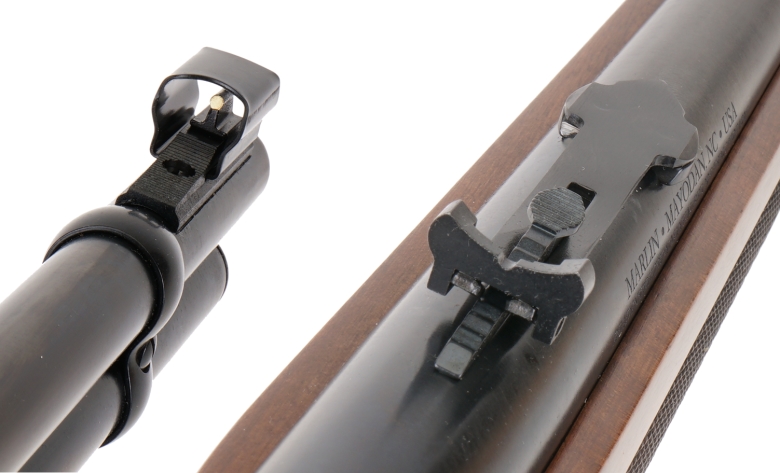
Traditional Model 1894 requires traditional semi-buckhorn sights and ramped front sight with a brass bead and hood. The rear sight stepped elevator permits adjustment for… elevation. A rear dovetail mount allows drifting with a nudge from a nylon dowel to zero windage adjustment. The rear leaf folds forward, if and when necessary, to clear a rifle scope’s objective bell.
What do you expect to hit without floating dots, optics or fog penetrating laser beams?…??
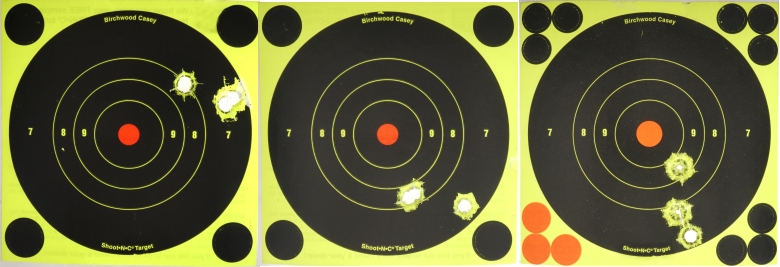
Shooting three shot groups at 50 yards, rifle’s forearm resting on a padded cast iron rest, buttstock settled into the ears of a bunny bag, and wearing my favorite “Wow! I can almost see” glasses concluded with the above results: L_R Hornady XTP 180 Grain 2116 fps 1.2″, Hornady FTX 225 Grain 1789 fps 1.2″, Federal Fusion 240 Grain 1796 fps 1.7″.
The method employed was to put the brass bead in the tiny notch at the center of the rear sight, get on target and squeeze off a shot… or three. The hood helps by shading the sight and providing a secondary reference outline on target. The set up is actually quite precise. Corroborating testimony from a good number of deer and hogs on request.
Along the way, with my earlier Model 1894 rifles, I have installed ghost sights, firesights, red dots, scopes, and a target grade peep sights. For 100 yard accuracy check out, a scope was installed.
After clearing a rain forest…
We have had rain by the buckets for a while. Consequently, the woods are a dense green. What was cleared only a few weeks ago, is already overgrown. So the range day began with a machete, a lopper, with way too short handles, and a brush saw on the attack until I had a 100 yard range, with enough clearance and visibility for safe shooting.
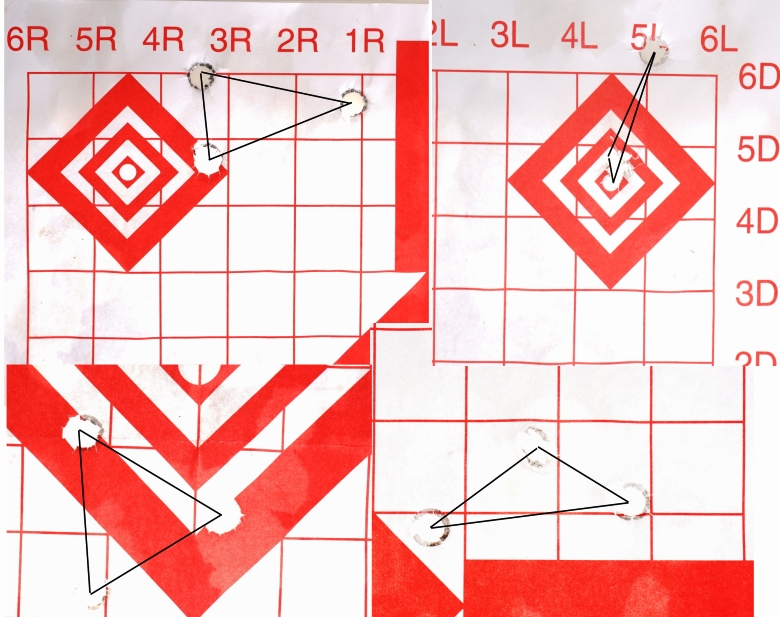
I apologize for the truly lousy image. That’s what thin paper targets look like when shot in the rain, dried with a shrink wrap blower and ironed out with the palms of my hands. Top Left – Federal Power-Shok 240 grain 2 1/4″, Top Right Hornady FTX 225 grain 1 3/4″, Bottom Left Hornady XTP 180 grain 1 3/4″, Bottom Right – Federal Fusion 240 grain 2″.
Accuracy and power
I am aware of social media firearm accuracy embellishments, so I ran my results through a real world to social media conversion calculator and the result was .25 to .50 MOA at 300 yards. Yes, that is sarcasm. In Maine, deer are most often harvested… yes, that means shot dead, inside 50 yards, so I am pretty sure the real world numbers would work quite well.
The Marlin Model 1894 is intended as a shortish range rifle for hunting medium to large size game. In other words, inside 100 yards and deer size game and similar. Could it be used for elk, eastern black bear, southern hogs? Sure. The 44 Remington magnum is a powerful handgun cartridge and it get even more powerful when shot through a 20″ barrel.

The cartridges pictured above are an eclectic selection, drawn from ammunition I had on hand and, within that mix, what represented the greatest diversity in bullet types. The idea was to see if I could trip up the loading, feed and ejection process with a variety of hard/soft bullets and various ogive profiles. The Marlin outsmarted me, falling for none of my tricks. Cycling was clean, even when mixing Special and Magnum ammunition in the 1894’s magazine.
| Type | Ammunition | Bullet Weight Grains |
Rated MV FPS |
Actual MV FPS |
Δ FPS |
| 44 Special | Hornady Critical Defense | 165 | 900 | 1597 | 697 |
| 44 Special | Federal Champion | 200 | 870 | 1681 | 811 |
| 44 Mag | Federal Power Shok | 180 | 1460 | 2229 | 769 |
| 44 Mag | Hornady Custom | 180 | 1550 | 2118 | 568 |
| 44 Mag | Federal Fusion | 240 | 1290 | 1803 | 513 |
| 44 Mag | Speer GD | 270 | 1250 | 1748 | 498 |
As a handgun cartridge, major ammunition manufacturers list 44 Remington Magnum ammunition for use on deer and elk, or large game up to 1500 lbs. In rifle applications, the increase in velocity and subsequently kinetic energy and improvements in down range performance, are significant.
In conclusion… I promise
The Marlin is an easy shooting rifle. Compact by most standards, and just a tick over 6 lbs in weight, there is enough there to tame the 44 Mag cartridge; moderate recoil and little muzzle climb. It is a good combination for wise hunters who do not want to haul an 8 lb rig up and down hills and through dense brush.
The new Model 1894 is… pretty. Wood and metal pieces are really nicely done and finishes are very traditional in appearance, but with modern wood finishes that are much improved in terms of providing wear, scratch and ding resistance.
This initial Marlin Model 1894 Classic release, suggests that the manufacturer has carefully anticipated overall demand and analyzed historical popularity of various Model 1894 configurations. Subsequently, they put their best Marlin foot forward to please the most Marlin fans.
I hope, at some point in the future, Ruger will introduce a walnut stocked, slimmed down 16″ barrel version, close to 5 lbs, with fiber optic sights and a windowed front hood. This way I can have a Ruger made Classic for most occasions and a stubby version for dragging though the woods of Maine. Nice job, Ruger.


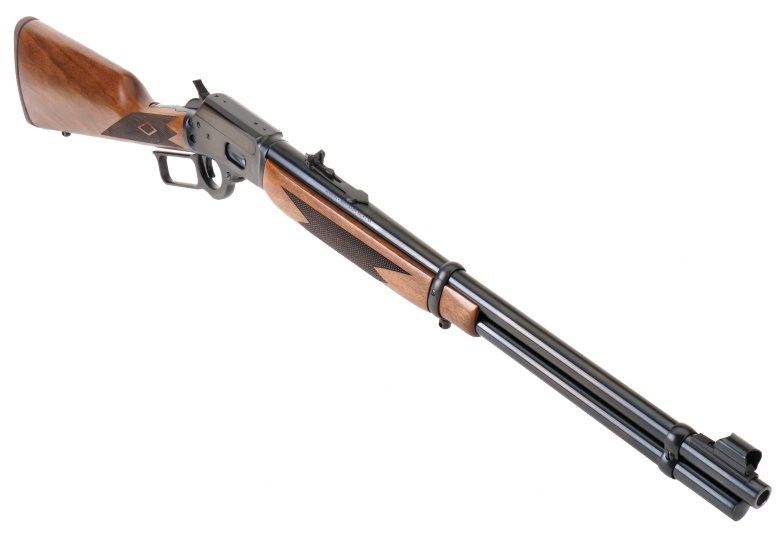
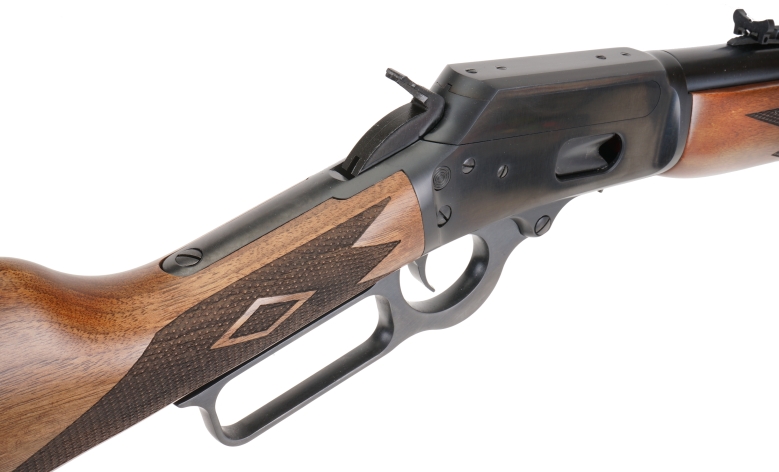
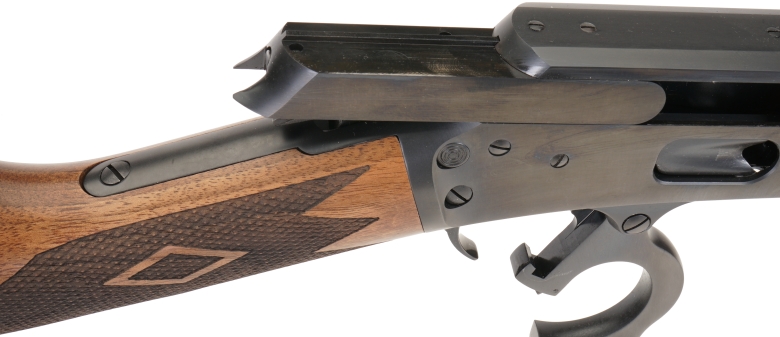



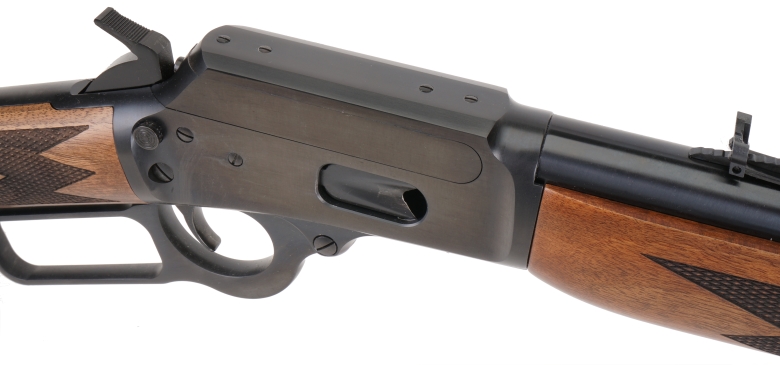
how would I find out how much this gun would cost ?? Robert krmasskell@shaw.ca 2504498044
Always the last row on the spec box in the article, Keith. The MSRP is $1,239, however, dealers can price higher or lower as they choose.
Joe